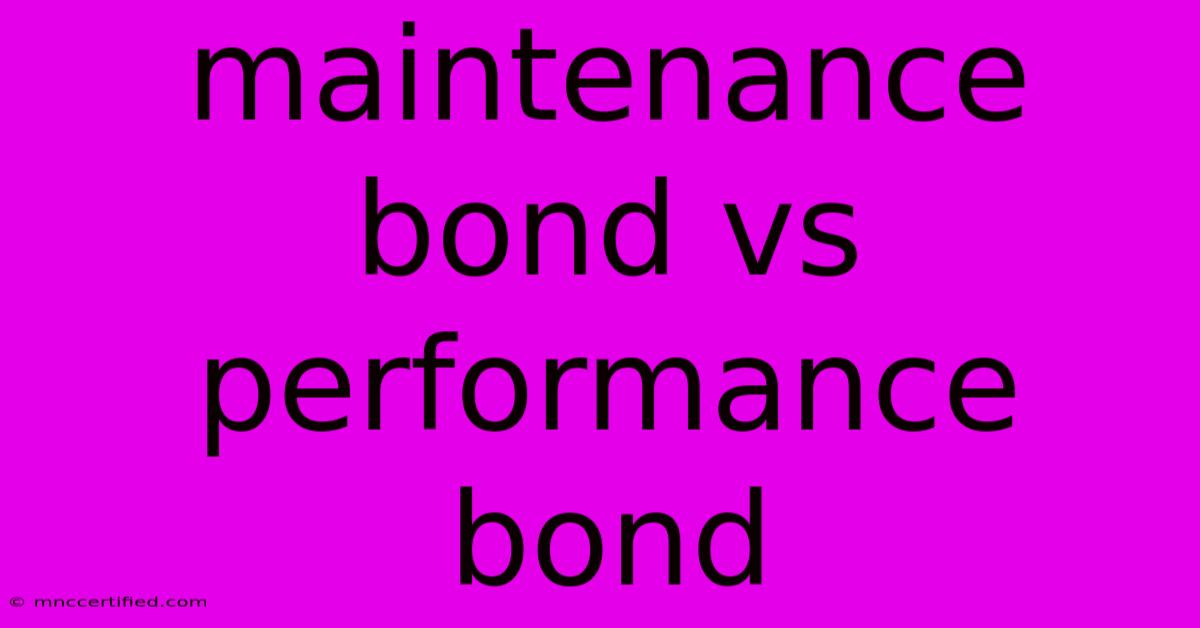Maintenance Bond Vs Performance Bond

Table of Contents
Maintenance Bond vs. Performance Bond: Understanding the Differences
When it comes to construction projects, ensuring quality and timely completion is paramount. To mitigate risks and protect the interests of all parties involved, bonds play a crucial role. Two common types of bonds are maintenance bonds and performance bonds. While they share some similarities, understanding their distinct functions is essential for making informed decisions.
Understanding Maintenance Bonds: Guaranteeing Defects
Maintenance bonds are specifically designed to guarantee the quality of a project's workmanship. They provide financial security to the owner in case defects arise after the project's completion. The bond typically covers the cost of repairing or replacing faulty materials, workmanship, or systems that fail within a specified period after the project's completion.
Here's how maintenance bonds work:
- Duration: They typically cover a specific period, commonly one to two years, although the duration can be longer depending on the project's scope and complexity.
- Trigger: The bond is activated if defects or malfunctions occur during the warranty period.
- Compensation: The bond issuer will provide financial compensation to cover the cost of repairs or replacements, ensuring the project is brought up to the agreed-upon standard.
Examples of defects covered by maintenance bonds:
- Cracks in concrete: A maintenance bond can cover repairs for cracks that appear in concrete walls or floors within the warranty period.
- Leaking pipes: If pipes leak due to faulty installation, the maintenance bond can cover the cost of replacing or repairing the affected plumbing system.
- Defective electrical wiring: Maintenance bonds often cover repairs for electrical problems that arise due to incorrect installation or material defects.
Understanding Performance Bonds: Ensuring Project Completion
Performance bonds are designed to ensure the contractor's ability to fulfill the project's obligations. They provide financial security to the owner if the contractor defaults on the contract, failing to complete the project on time and within budget.
Key features of performance bonds:
- Guarantees completion: They ensure that the project will be completed as per the terms of the contract, even if the contractor faces unforeseen difficulties.
- Protection for the owner: The owner is protected from financial losses if the contractor abandons the project or fails to complete it according to the agreed-upon specifications.
- Financial backing: The bond issuer is obligated to step in and complete the project if the contractor defaults, providing financial support to cover the remaining costs.
Examples of situations where performance bonds are crucial:
- Contractor bankruptcy: If the contractor goes bankrupt during the project, the performance bond can cover the cost of hiring a new contractor to complete the remaining work.
- Project delays: If the contractor fails to meet project deadlines due to unforeseen circumstances, the performance bond can cover the costs associated with project delays, such as extended labor or material costs.
- Non-compliance with specifications: If the contractor fails to meet the project's specifications, the performance bond can cover the cost of correcting the non-compliant work.
Choosing the Right Bond: A Balancing Act
Choosing the right bond type depends on the specific needs of your project. Here's a helpful guide:
- Prioritize quality: If you are primarily concerned with the long-term quality and durability of the project, a maintenance bond is crucial. It provides peace of mind knowing that any defects will be addressed promptly.
- Ensure project completion: If your main concern is ensuring the project's timely completion, a performance bond is essential. It safeguards against financial losses if the contractor defaults.
- Combine for comprehensive protection: For maximum protection, consider obtaining both a maintenance bond and a performance bond. This comprehensive approach provides a safety net for all aspects of your project.
Additional Considerations
- Bond amount: The bond amount is typically a percentage of the project's total cost. This percentage can vary depending on factors such as project complexity, the contractor's experience, and the level of risk involved.
- Bond issuer: The bond issuer is typically a surety company, which is a financial institution specializing in providing insurance guarantees.
- Contractual terms: Carefully review the terms of the bond contract to understand the specific coverage, duration, and procedures for filing claims.
Remember: The importance of obtaining appropriate bonds cannot be overstated. By understanding the differences between maintenance bonds and performance bonds and choosing the right ones for your project, you can mitigate risks and protect your investment.

Thank you for visiting our website wich cover about Maintenance Bond Vs Performance Bond. We hope the information provided has been useful to you. Feel free to contact us if you have any questions or need further assistance. See you next time and dont miss to bookmark.
Featured Posts
-
Eagles Vs Cowboys Watch Live Game
Nov 11, 2024
-
Eagles Vs Cowboys 10 Stats To Watch
Nov 11, 2024
-
Gbu Financial Life Insurance Company
Nov 11, 2024
-
Efl Round Up Sheffield United Wins Steel City Derby
Nov 11, 2024
-
2024 Mtv Emas Live Stream Your Guide
Nov 11, 2024